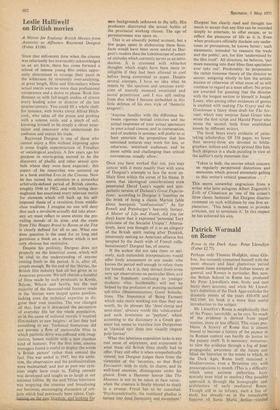Patrick Wormald on Rome
Rome in the Dark Ages Peter Llewellyn (Faber £2.75) Perhaps only Thomas Hodgkin, since Gib- bon, has seriously concerned himself with the most obscure and least glamorous period (present times excepted) of Italian history in general, and Roman in particular. But, now, the British School in Rome has produced Mr Peter Llewellyn's new, lively and (not least) short account; and while Mr Llewel- lyn's definition of the Dark Ages excludes the dramatic events of the years 410.476 and 962-1049, his book is a more than useful introduction to the subject.
Mr Llewellyn's Rome is emphatically that of the Popes; inevitably, as he says. So much of the evidence is derived from papal sources, more or less official. This raises pro- blems. A history of Rome that is almost bound to become a history of the papacy in its Roman context can hardly do justice to the papacy itself. It is necessary, moreover, to view the evidence through a fog of later propaganda; awareness of the future can blind the historian to the extent to which, in the Dark Ages, Rome itself remained a Mediterranean, even a Byzantine city, with preoccupations to match. (This is a difficulty which some eminent authorities. have scarcely even tried to resolve.) One possible approach is through the iconography and architecture of early mediaeval Rome. Though still in its infancy, such a line of study has already—as in the remarkable frescoes of, Santa Maria „AnAeg---yielded
results which put Rome emphatically where, in the Dark Ages, it belonged: in the world of Mediterranean culture. One of the merits of Mr Llewellyn's book is that it does some justice to such evidence; and it is therefore a Pity that it is not more extensively illustrated.
It is also a pity that not all the problems of approach are squarely faced. As a result, we have some conventional judgments which, frankly, are overdue for reassessment— where, indeed, they have not been reassessed. A Gregory the Great who 'conceived the design of converting the northern world into a new unity under Rome, the unity of the Church' does not really make much sense (any more than does a Liutprand or a Louis it aiming at a united Italy); the evidence of Gregory's own writings supports no verdict better than that of Bede: 'His sole concern was to save souls,' confronted as he was by a conviction of imminent apocalypse. Nor, on the other hand, is it possible to understand the policies of Nicholas 1, Hadrian it and John viti, the three greatest ninth-century Popes, in terms purely of the alignment of Roman factions, for and against the German Emperors.
Mr Llewellyn's Roman world Is sometimes too big, and it is sometimes too small. But he has much to say that is interesting about the sources of papal wealth, and the structure and morale of the papal household (the Lateran Palace, repeatedly sacked, yet always available for further devastation, is one of the heroes of the book). He has some delightful pages on the frantic attempts of grand senatorial families to slot saints and martyrs into their genealogies, and on the problems of an early mediaeval relic-monger. The comments of a ninth-century Frankish monk on the long hair of Roman youth recall other times, places and journals (they were even known as 'Pretty Things'). It is Perhaps for these, descriptive, analytical passages, and the account of Santa Maria Antica that his book will be most valued.
Patrick Worwald is a Fellow of All Souls College, Oxford



































 Previous page
Previous page